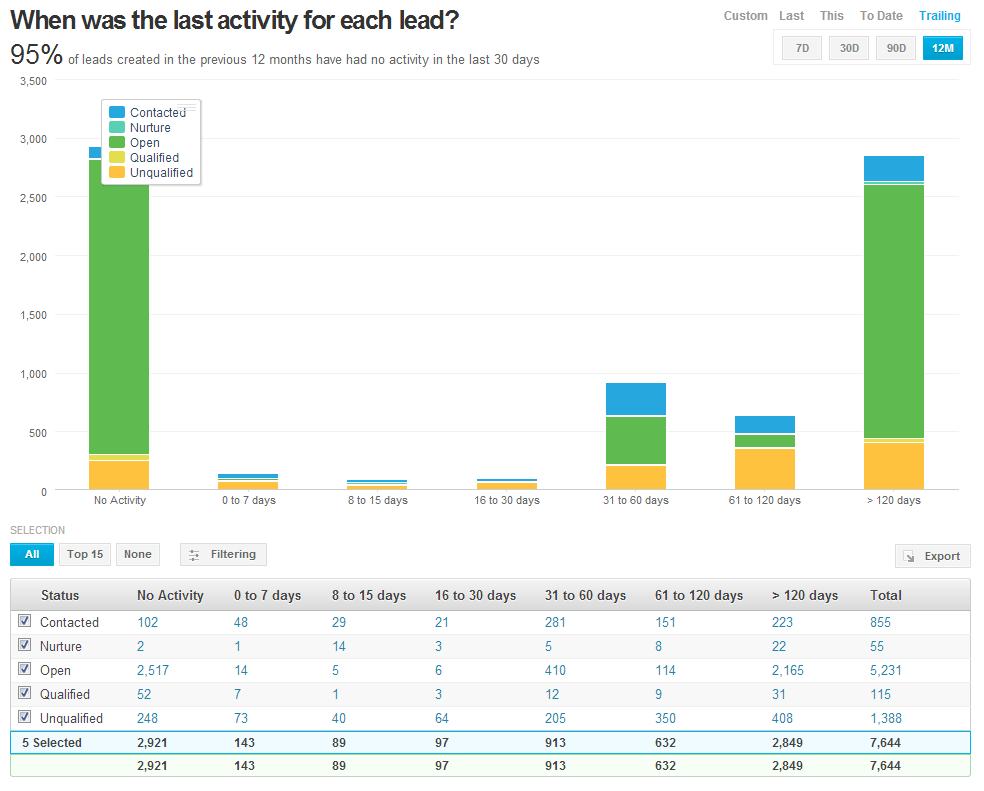Sales are slow, revenue is down and your CEO wants to know why. As the VP of Sales, you need to diagnose the problems and make changes immediately so your team doesn’t fall short of the goals this quarter. But how do you get to the root of your sales troubles?
This list of 25 reasons covers the biggest obstacles facing sales, and offers insight and advice on how to overcome them.
1. Unclear Insight into Wins and Losses
If you don’t know what winning deals look like, how can you replicate them in the future? And if you don’t know why you’re losing deals, how can you avoid making the same mistakes again? Look back at your sales results using analytics to zero in on what works, what doesn’t, and how you can start winning more deals.
2. Senior Management Shifts
When there is a big shake-up in management, it can seriously impact your sales team’s results for months afterward. Changes at the top trickle down to the bottom, and can confuse even long-time reps. Make sure you’re clear and open with your team about new expectations and any changes in sales strategy or reporting.
3. Compensation Confusion
Do your sales reps know exactly how their compensation plan works? If sales incentives were recently altered or are very complex, your team may be confused and feel unmotivated to sell.
4. Marketing Dropped the Ball
If the marketing team isn’t handing over the right number of qualified leads to your sales team, that’s going to hurt numbers. Look into whether marketing has changed gears, maybe cutting back on a successful Google Ad campaign. If you get to the root of the problem, you’ll see your numbers jump back up.
5. No Sales Follow-up
Your sales reps have to follow up on every single lead, no matter what. Look at the follow-up numbers for the past few months and pinpoint any leads that are being ignored. If your sales team is dropping the ball on any of your leads, it can lead to fewer deals closed.

What is the basis for your sales forecasting? If you’re not using historical data to extrapolate your sales quarter to quarter, you’re really just guessing. Using data analytics will significantly improve the accuracy and reliability of your forecasts, so you won’t fall short of your goal next time.
7. Hiring the Wrong People
Hiring talented sales reps can be extremely difficult. You need to hire people who are smart, passionate and also willing to be coached to success. Take a good look at your team and consider if maybe you’ve hired the wrong kind of reps, and consider re-tooling your hiring process altogether.
8. Ignoring the Competition
If you’re not aware of what your major competitors are doing, you’re flying blind. Look to see whether your competitors have seen an increase in sales, while you’re experiencing a decrease. This means you have a serious problem, and need to ramp up marketing and sales to take back some of the market share.
9. Confusing Quotas
Do your sales reps all know exactly what goals they have to meet each month, quarter and year? If not, your team may not be motivated to work as hard as you’d like. Consider implementing a sales leaderboard to push your team to reach competitive goals using gamification.
Download our Free Sales Leaderboard App for Salesforce.com today.
10. Minimal Sales Training
If you have not invested enough time into training your sales team, you will not see the high sales performance you’d like. Extensive training on products, re-training on new products, sales training classes, and more, are all necessary to see your workforce to succeed long-term.
11. No Differentiation Between Inside and Outside Sales
The skills it takes to be a successful inside sales rep are very different than the skills your outside sales reps need. Make sure you emphasize the difference between the two in hiring, training, resources, goals and support from management. Don’t be afraid to shift reps to a different department where their personality and skills will shine.
12. Ineffective Sales Pipeline Management
If you’re not aware of every detail in your sales pipeline, you are not in control of your sales team. Use analytics to carefully track key metrics like how successful deals behave as they move through the pipeline, the overall pipeline growth, and more.
Download our Free Pipeline Analytics App for Salesforce.com now.
13. Not Enough Sales Coaching
With everything else on sales managers’ plates, coaching can easily fall through the cracks. Make sure your sales team is receiving consistent, one-on-one coaching focused on improving their sales skills to boost performance.
14. Relying on Hockey Stick Sales
Do your sales reps consistently deliver the majority of their sales in the last week or two each quarter? This can be difficult to rely on and put undue pressure on your team. Try paying monthly bonuses for reps that make their quota without resorting to last-minute sales.
15. Bad Time Management by Sales Reps
Your sales reps should be logging their daily activities so you can track how many calls they make, how many meetings they book and how many demos they give. By tracking activities, you can see if any reps are falling behind and encourage them to step up and make more dials.
16. New Product Confusion
If your company recently released a new product, make sure your sales reps are all completely comfortable selling it. Train reps on the specs, the expected market, the sales pitch and more to more effectively sell your new offering.
17. Clashes with Marketing
If marketing and sales aren’t aligned, this will reflect in your sales numbers. When the handoff of leads from marketing isn’t smooth, or if the two groups have vastly different goals, you need to work on your alignment with marketing.
18. Bad Performance is Tolerated
Is your sales team a true meritocracy? It can be difficult to decide to fire someone, and more difficult to go through the time-consuming process of hiring someone to replace them. But though it’s tough, don’t let your sales team stagnate and allow a bad performer to bring down numbers.
19. Product is Devalued
Price cuts can sometimes backfire. If you cut your price by too much, you can hurt your margins and still not increase profits overall. Consult with marketing about possibly increasing the price and changing the image of your product in the marketplace.
20. CRM is Underutilized
If you’re using Salesforce or another Customer Relationship Management (CRM) software correctly, it can be an incredibly useful tool for sales reps and managers. But if you haven’t customized your CRM or don’t follow best practices, you’re wasting a powerful tool.
21. Relying on Spreadsheets for Analysis
Sales reporting has come a long way, and you don’t have to struggle with Excel anymore. Spreadsheets are difficult to use, error-prone and can’t provide as much information as some of the more sophisticated business analytics tools out there.
22. Working Unqualified Leads
If marketing is handing over unqualified sales inquiries, even a huge number of leads is not helpful to your sales team. Your reps will be wasting time chasing down prospects who aren’t interested in your product, have no purchasing power, or aren’t in the right industry. Implement a plan to qualify leads extensively before handing them to sales.
23. Generating Inconsistent Leads
When your sales reps get three leads one month and 40 next month, it’s no wonder that you’re experiencing boom and bust inconsistencies. Make sure you grow the pipeline consistently as you close deals, so you don’t end up with insufficient opportunities for reps next month.
24. Low Visibility
Is your company nearly invisible online? When prospects have a difficult time out who you are, it’s tough for them to buy your product. Make sure your company is investing in SEO, PR, advertising campaigns, content marketing and more to increase product visibility.
25. Complacency
Over time, your sales reps will start to get comfortable, and that’s not a good thing. Each month, you should push them to reach a higher sales quota and stretch their skills. Don’t push too hard, but make sure to challenge your team.
Now that you understand some of the major hurdles that can slow down your sales team, it’s time to make adjustments. By implementing some of the highest-level solutions to these problems, your sales team will stop struggling and start succeeding.

